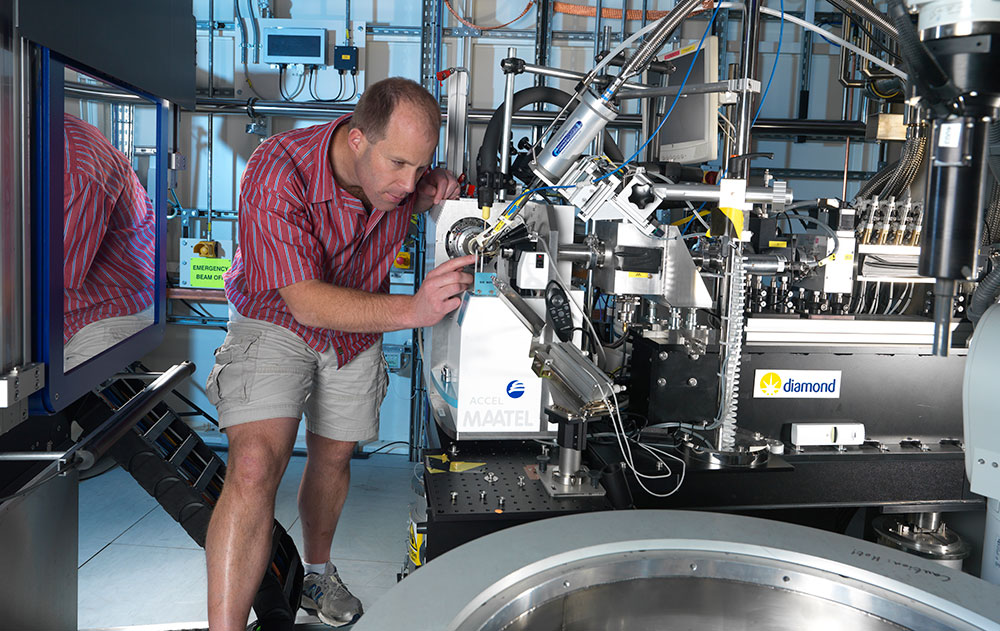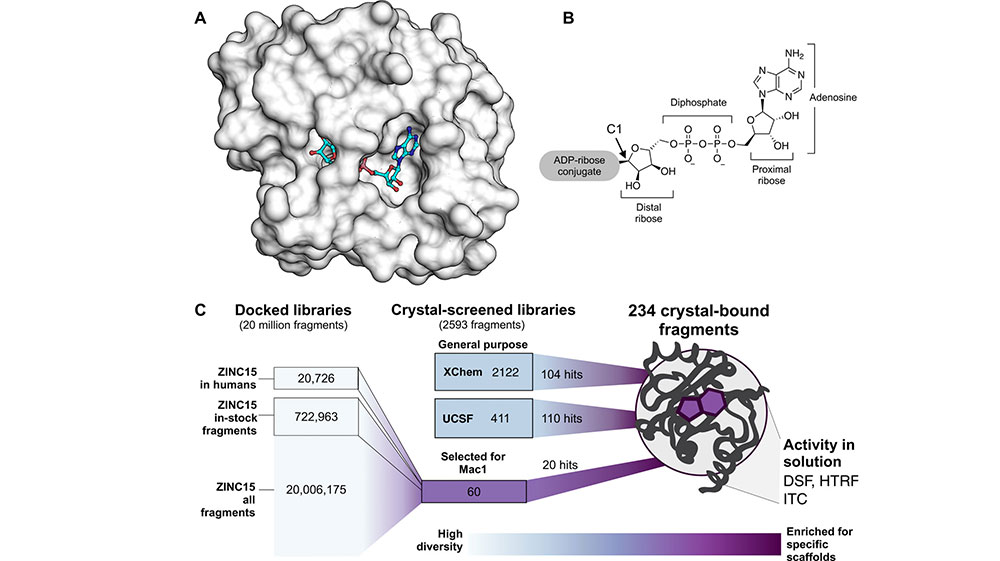Massive Fragment Screen Points Way to New SARS-CoV-2 Inhibitors
Experiment with 2533 fragment compounds generates chemical map to future antiviral agents
May 7, 2021
 enlarge
enlarge
Principal Beamline Scientist, Frank von Delft, on I04-1 at Diamond Light Source." Image credit: Diamond Light Source
This news release, originally issued by Diamond Light Source, describes a template for how to develop directly-acting antivirals that would combat COVID-19. The study focused on a specific part of the Nsp3 gene that SARS-CoV-2 uses to suppress the host cell’s natural antiviral response. Researchers from the University of California used the Highly Automated Macromolecular Crystallography (AMX) and the Frontier Microfocusing Macromolecular Crystallography (FMX) beamlines at the National Synchrotron Light Source II (NSLS-II) to characterize the molecular structure of proteins involved in this mechanism. The beamlines' ultrasmall yet powerful x-rays and rapid sample mounting automation enabled the researchers to collect hundreds of high-resolution datasets per eight-hour shift. NSLS-II is a U.S. Department of Energy (DOE) Office of Science User Facility at DOE’s Brookhaven National Laboratory that offers a comprehensive suite of life science research capabilities. For more information on Brookhaven’s role in this research, please contact Cara Laasch, 631-344-8458, laasch@bnl.gov.
New research published in Science Advances provides a template for how to develop directly-acting antivirals with novel modes of action, that would combat COVID-19 by suppressing the SARS-CoV-2 viral infection. The study focused on the macrodomain part of the Nsp3 gene product that SARS-CoV-2 uses to suppress the host cell’s natural antiviral response. This part of the virus’s machinery, also known as Mac1, is essential for its reproduction: previous studies have shown that viruses that lack it cannot replicate in human cells, suggesting that blocking it with a drug would have the same effect.
The study involved a crystallographic fragment screen of the Nsp3 Mac1 protein by an open science collaboration between researchers from the University of Oxford, the XChem platform at Diamond, and researchers from the QCRG Structural Biology Consortium at the University of California San Francisco. The international effort discovered 234 fragment compounds that directly bind to sites of interest on the surface of the protein, and map out chemical motifs and protein-compound interactions that researchers and pharmaceutical companies can draw on to design compounds that could be developed into antiviral drugs. This work is thus foundational for preparing for future pandemics.
Principal Beamline Scientist, Frank von Delft, said: "Robustly identifying this kind of chemical matter for promising and tractable targets like Nsp3 is a first step in rational drug discovery. This is always a long journey fraught with difficulty and failure, but the battery of new structural biology methods that we combined in this study, including fragment screening at Diamond and computational docking at UCSF, are helping to change drug discovery and make it easier to find effective drug candidates."
 enlarge
enlarge
Overview of the fragment discovery approach for SARS-CoV-2 Nsp3 Mac1 presented in this study. (A) Surface representation of Nsp3 Mac1 with ADPr bound (cyan) in a deep and open binding cleft. (B) Nsp3 Mac1 has (ADP-ribosyl)hydrolase activity, which removes ADP-ribosylation modifications attached to host and pathogen targets. ADPr is conjugated through C1 of the distal ribose. (C) Summary of the fragment discovery campaign presented in this work. Three fragment libraries were screened by crystallography: two general-purpose [XChem and University of California San Francisco (UCSF)] and a third bespoke library of 60 compounds, curated for Mac1 by molecular docking of more than 20 million fragments. Crystallographic studies identified 214 unique fragments binding to Mac1, while the molecular docking effort yielded in 20 crystallographically confirmed hits. Several crystallographic and docking fragments were validated by isothermal titration calorimetry (ITC), differential scanning fluorimetry (DSF), and a HTRF-based ADPr-peptide displac
These fragments cover a wide range of chemical motifs, and the study lays out the next steps of designing more elaborate molecules that combine the observed themes, synthesizing them and confirming experimentally whether they strongly bind the protein and have a biological effect. The most promising compounds can then be progressed in fully-fledged drug discovery programmes, which includes not only improving the biological potency but also ensuring the final molecule has important drug properties such as easy absorption and minimal side effects.
Most drugs contain a few key components that cause the desired, effect while the rest of the molecule may be important for other reasons, such as solubility, uptake from the gut or how the drug is processed by our metabolism. Traditional high-throughput screening entails testing very large collections of bigger, generally sub-optimal molecules, which are experiment of great complexity.
Instead, fragment screening is an approach for identifying building blocks of the future drug molecule, observing how they interact with the protein under study, contextualizing those interactions, and providing starting points for molecules that directly influence the biology of the protein. This method significantly reduces the number of compounds that need to be screened to find one that really binds, while still informing a broad range of potential molecules. Doing the experiment by structural biology, as implemented at the XChem platform, yields this information directly in 3D, greatly accelerating up the design process and ensuring a far more cost-effective overall experiment.
The UCSF collaborators also used another innovative drug discovery technique, Computational Docking. This deploys computer models and simulations to assess the likely interactions of virtual molecules for favourable interactions with Mac1 and their promise as starting points for drug discovery. The team identified 60 candidates from a virtual library of 20 million molecules, which were then experimentally tested using X-ray crystallography, yielding 20 good hits.
Frank von Delft, concluded: "This is a significantly higher-than-random hit rate, validating the new specific docking methodologies developed by our UCSF colleagues. The high quality structural data of Mac1 that we obtained by X-ray crystallography was essential, but the validation of the approach means that in future, we have additional power for exploring compounds that are not physically available.
"Overall, this work not only accelerates our ability to validate whether targeting NSP3 Mac1 is an effective way to develop antivirals; it also is hugely valuable in improving the template of methodologies for future inhibitor discovery and development throughout the community of drug discovery."
2021-18827 | INT/EXT | Newsroom









